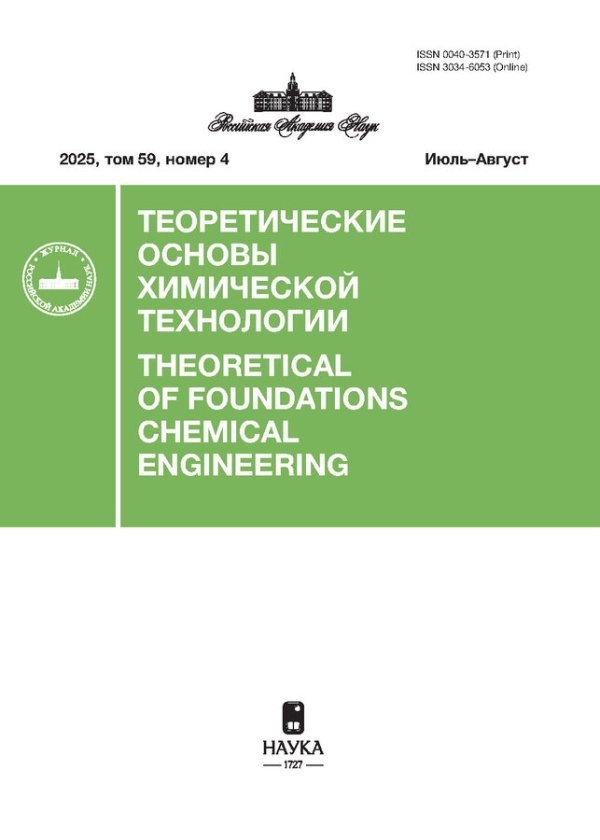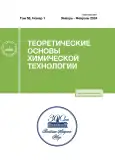Эрозионная ультразвуковая очистка катодной ленты отработанных литий-ионных аккумуляторов типа NMC
- Authors: Градов О.М.1, Зиновьева И.В.1, Заходяева Ю.А.1, Вошкин А.А.1
-
Affiliations:
- Институт общей и неорганической химии им. Н. С. Курнакова РАН
- Issue: Vol 58, No 1 (2024)
- Pages: 35-42
- Section: Articles
- Published: 21.07.2024
- URL: https://journals.rcsi.science/0040-3571/article/view/260027
- DOI: https://doi.org/10.31857/S0040357124010057
- EDN: https://elibrary.ru/ZEBNYI
- ID: 260027
Cite item
Full Text
Abstract
Предложен метод очистки катодной фольги отработанного литий-ионного аккумулятора от катодного материала с помощью ультразвука. Разработана общая схема компоновки устройств с анализом взаимодействия всех основных узлов конструкции. В основу метода положен эффект кавитационной ультразвуковой эрозии твердых тел, помещенных в жидкость, которая находится под воздействием ультразвука. Получено выражение для глубины слоя покрытия, который удаляется с ленты при однократном прохождении всей ее длины через все зоны кавитации устройства. Выполнен аналитический и численный анализ зависимости скорости очистки от интенсивности ультразвука, его частоты, скорости движения ленты и других параметров схемы. Экспериментально показана возможность эффективной очистки алюминиевой фольги от катодного материала литий-ионного аккумулятора типа NMC.
About the authors
О. М. Градов
Институт общей и неорганической химии им. Н. С. Курнакова РАН
Author for correspondence.
Email: lutt.plm@igic.ras.ru
Russian Federation, Москва
И. В. Зиновьева
Институт общей и неорганической химии им. Н. С. Курнакова РАН
Email: lutt.plm@igic.ras.ru
Russian Federation, Москва
Ю. А. Заходяева
Институт общей и неорганической химии им. Н. С. Курнакова РАН
Email: lutt.plm@igic.ras.ru
Russian Federation, Москва
А. А. Вошкин
Институт общей и неорганической химии им. Н. С. Курнакова РАН
Email: lutt.plm@igic.ras.ru
Russian Federation, Москва
References
- Nitta N., Wu F., Lee J.T., Yushin G. Li-Ion Battery Materials: Present and Future // Materials Today. 2015. V. 18. № 5. P. 252–264. https://doi.org/10.1016/j.mattod.2014.10.0402.
- Harper G., Sommerville R., Kendrick E., Driscoll L., Slater P., Stolkin R. et al. Recycling lithium-ion batteries from electric vehicles // Nature. 2019. № 575. P. 75–86. https://doi.org/10.1038/s41586-019-1682-53.
- Xie, J., Lu Y.-C. A Retrospective on Lithium-Ion Batteries // Nat. Commun. 2020. V. 11. № 1. P. 2499. https://doi.org/10.1038/s41467–020–16259–94.
- Torkaman R., Asadollahzadeh M., Torab-Mostaedi M., Ghanadi Maragheh M. Recovery of cobalt from spent lithium ion batteries by using acidic and basic extractants in solvent extraction process // Sep. Purif. Technol. 2017. V. 186. P. 318–325, https://doi.org/10.1016/j.seppur.2017.06.0235.
- Fan E., Li L., Wang Z., Lin J., Huang Y., Yao Y., Chen R., Wu F. Sustainable recycling technology for li-ion batteries and beyond: challenges and future prospects // Chem. Rev. 2020. V. 120. № 14. P. 7020–7063. https://doi.org/10.1021/acs.chemrev.9b005356.
- Ma Y., Svärd M., Xiao X., Gardner J.M., Olsson R.T., Forsberg K. Precipitation and crystallization used in the production of metal salts for li-ion battery materials: a review // Metals. 2020. V. 10. № 12. P. 1609. https://doi.org/10.3390/met101216097.
- Kim K., Raymond D., Candeago R., Su X. Selective cobalt and nickel electrodeposition for lithium-ion battery recycling through integrated electrolyte and interface control // Nat. Commun. 2021. V. 12. № 1. P. 6554. https://doi.org/10.1038/s41467-021-26814-78.
- Jin S., Mu D., Lu Z., Li R., Liu Z., Wang Y., Tian S., Dai C. A comprehensive review on the recycling of spent lithium-ion batteries: urgent status and technology advances // J. Clean. Prod. 2022. V. 340. P. 130535. https://doi.org/10.1016/j.jclepro.2022.1305359.
- Jung J.C.-Y., Sui P.-C., Zhang J. A Review of recycling spent lithium-ion battery cathode materials using hydrometallurgical treatments // J. Energy Storage. 2021. V. 35. P. 102217. https://doi.org/10.1016/j.est.2020.10221710.
- Lei S., Sun W., Yang Y. Solvent Extraction for Recycling of Spent Lithium-Ion Batteries // J. Hazard Mater. 2022. V. 424. P. 127654. https://doi.org/10.1016/j.jhazmat.2021.12765411.
- Qin L., Di J., He Y. Efficient synthesis of furfuryl alcohol from corncob in a deep eutectic solvent system // Processes. 2022. V. 10. P. 1873. https://doi.org/10.3390/pr1009187312.
- Gradov O.M., Zinov’eva I.V., Zakhodyaeva Yu.A., Voshkin A. A. Kinetics of ultrasonic dissolution of metal oxide powder for different spatial combinations of the cavitation region and eckart acoustic flow // Theor Found. Chem. Eng. 2023. V. 57. P. 255–264. https://doi.org/10.1134/S004057952303006513.
- Zhang T., He Y., Ge L., Fu R., Zhang X., Huang, Y. Characteristics of wet and dry crushing methods in the recycling process of spent lithium-ion batteries // J. Power Sources. 2013. V. 240. P. 766–771. https://doi.org/10.1016/j.jpowsour.2013.05.00914.
- Chen L., Tang X., Zhang Y., Li L., Zeng Z., Zhang Y. Process for the recovery of cobalt oxalate from spent lithium-ion batteries // Hydrometallurgy. 2011. V. 108. P. 80–86. https://doi.org/10.1016/j.hydromet.2011.02.01015.
- Li J., Shi P., Wang Z., Chen Y., Chang C.-C. A Combined recovery process of metals in spent lithium-ion batteries // Chemosphere. 2009. V. 77. P. 1132–1136. https://doi.org/10.1016/j.chemosphere.2009.08.04016.
- Wang M., Tan Q., Liu L., Li J. Efficient separation of aluminum foil and cathode materials from spent lithium-ion batteries using a low-temperature molten salt // ACS Sustain Chem. Eng. 2019. V. 7. P. 8287–8294. https://doi.org/10.1021/acssuschemeng.8b0669417.
- Zou H., Gratz E., Apelian D., Wang Y. A Novel method to recycle mixed cathode materials for lithium ion batteries // Green Chemistry. 2013. V. 15. P. 1183. https://doi.org/10.1039/c3gc40182k18.
- Zeng X., Li J. Innovative application of ionic liquid to separate al and cathode materials from spent high-power lithium-ion batteries // J. Hazard Mater. 2014. V. 271. P. 50–56. https://doi.org/10.1016/j.jhazmat.2014.02.00119.
- Gu K., Chang J., Mao X., Zeng H., Qin W., Han J. Efficient separation of cathode materials and al foils from spent lithium batteries with glycerol heating: a green and unconventional way // J. Clean Prod. 2022. V. 369. P. 133270. https://doi.org/10.1016/j.jclepro.2022.13327020.
- Wang H., Liu J., Bai X., Wang S., Yang D., Fu Y., He Y. Separation of the cathode materials from the al foil in spent lithium-ion batteries by cryogenic grinding // Waste Management. 2019. V. 91. P. 89–98. https://doi.org/10.1016/j.wasman.2019.04.05821.
- Zinov’eva I.V., Fedorov A.Ya., Milevskii N.A., Zakhodyaeva Yu.A., Voshkin A.A. Dissolution of metal oxides in a choline chloride – sulphosalicylic acid deep eutectic solvent // Theor. Found. Chem. Eng. 2021. V. 55. P. 663–670. https://doi.org/10.1134/S004057952104037022.
- Ijardar S.P., Singh V., Gardas R.L. Revisiting the physicochemical properties and applications of deep eutectic solvents // Molecules. 2022. V. 27. P. 1368. https://doi.org/10.3390/molecules2704136823.
- Gradov O.M., Zinov’eva I.V., Zakhodyaeva Y.A., Voshkin A.A. Modelling of the erosive dissolution of metal oxides in a deep eutectic solvent – choline chloride/sulfosalicylic acid – assisted by ultrasonic cavitation // Metals. 2021. V. 11. P. 1964. https://doi.org/10.3390/met1112196424.
- Zinov’eva I.V., Fedorov A.Ya., Milevskii N.A., Zakhodyaeva Yu.A., Voshkin A.A. A deep eutectic solvent based on choline chloride and sulfosalicylic acid: properties and applications // Theor. Found. Chem. Eng. 2021. V. 55. P. 371–379. https://doi.org/10.1134/S004057952103024625.
- Milevsky N.A., Zinovieva I.V., Zakhodyaeva Yu.A., Voshkin A.A. Extractive Separation of Co/Ni pair with the deep eutectic solvent aliquat 336/Timol // Theor. Found. Chem. Eng. 2022. V. 56. P. 45–52. https://doi.org/10.1134/S0040579522010080
- Milevskii N.A., Zinov’eva I.V., Zakhodyaeva Yu.A., Voshkin A.A. Separation of Li(I), Co(II), Ni(II), Mn(II), and Fe(III) from hydrochloric acid solution using a menthol-based hydrophobic deep eutectic solvent // Hydrometallurgy. 2022. V. 207. P. 105777. https://doi.org/10.1016/j.hydromet.2021.10577727.
- Flynn H. G. Physics of Acoustic Cavitations in Liquids // Physical acoustics – Principles and methods. NY.: Academic Press, 1964, P. 376.
Supplementary files










